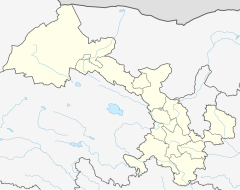The Huasi Mosque (Chinese: 华寺清真寺; pinyin: Huá Sì Qīng Zhēn Sì; lit. 'Multicoloured Mosque') is a mosque in China built during the reign of the Chenghua Emperor (r. 1465–1487) in the Ming dynasty. Buddhist temples and imperial palaces were the architecture on which the construction for the mosque was based. It was constructed by Muslims living in West Phoenix Wood Town, now the Bafang areas of Linxia City, Gansu. Ma Zhongying's 1928 revolt in the Muslim conflict in Gansu (1927–30) led to a blaze that destroyed the building. It was capable of holding 2,000 people being 5 mu in area after reconstruction of the Mosque in 1941.[1]
| Huasi Mosque | |
|---|---|
華寺清真寺 | |
 | |
| Religion | |
| Affiliation | Islam |
| Branch/tradition | Sunni |
| Location | |
| Location | Linxia, Gansu, China |
| Geographic coordinates | 35°35′17.6″N 103°11′59.7″E / 35.588222°N 103.199917°E |
| Architecture | |
| Type | mosque |
See also
editReferences
edit- ^ Michael Dillon (1999). China's Muslim Hui community: migration, settlement and sects. Richmond: Curzon Press. p. 119. ISBN 0-7007-1026-4.
Wikimedia Commons has media related to Huasi Gongbei.
